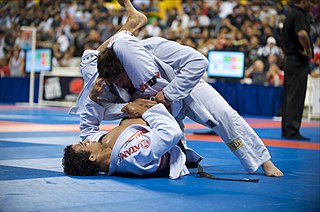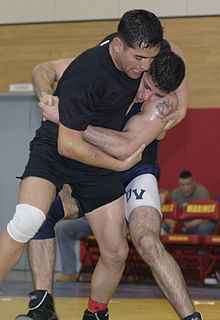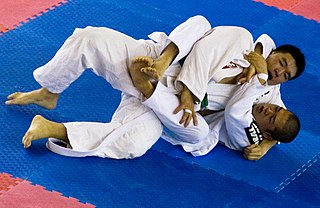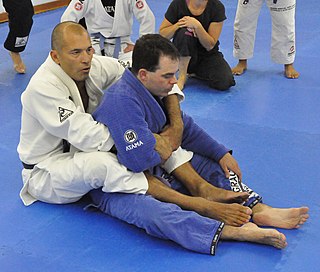
Grappling, in hand-to-hand combat, describes sports that consist of gripping or seizing the opponent. Grappling is used at close range to gain a physical advantage over an opponent, either by imposing a position or causing injury. Grappling is a broad term that encompasses many disciplines. These various martial arts can be practiced both as combat sports and for self-defense. Grappling contests often involve takedowns and ground control, and may end when a contestant concedes defeat, also known as a submission or tap out.

Brazilian Jiu-Jitsu is a martial art and combat sport based on ground fighting (ne-waza) and submission holds. BJJ focuses on the skill of taking an opponent to the ground, controlling one's opponent, gaining a dominant position, and using a number of techniques to force them into submission via joint locks or chokeholds.

The guard is a ground grappling position in which one combatant has their back to the ground while attempting to control the other combatant using their legs. In pure grappling combat sports, the guard is considered an advantageous position, because the bottom combatant can attack with various joint locks and chokeholds, while the top combatant's priority is the transition into a more dominant position, a process known as passing the guard. In the sport of mixed martial arts, as well as hand-to-hand combat in general, it is possible to effectively strike from the top in the guard, even though the bottom combatant exerts some control. There are various types of guard, with their own advantages and disadvantages.

Ground fighting is hand-to-hand combat which takes place while the combatants are on the ground. The term is commonly used in mixed martial arts and other combat sports, as well as various forms of martial arts to designate the set of grappling techniques employed by a combatant that is on the ground. It is the main focus of Brazilian Jiu-Jitsu and is featured in varying amounts in Catch wrestling, Judo, Sambo, Shoot wrestling, Dishuquan Dog Kung Fu, some schools of Shuai Jiao and other styles of wrestling.
A triangle choke, or sankaku-jime (三角絞) in judo, is a type of figure-four chokehold that encircles the opponent's neck and one arm with the legs in a configuration similar to the shape of a triangle. Applying pressure using both legs and the opponent's own shoulder, the technique is a type of lateral vascular restraint that constricts the blood flow from the carotid arteries to the brain, potentially resulting in loss of consciousness in seconds when applied correctly. Recent studies have shown that the triangle choke takes an average of 9.5 seconds to render an opponent unconscious from the moment it is properly applied.
An armlock in grappling is a single or double joint lock that hyperextends, hyperflexes or hyperrotates the elbow joint or shoulder joint. An armlock that hyper-extends the arm is known as an armbar, and it includes the traditional armbar, pressing their elbow into your thigh, and the triangle armbar, like a triangle choke, but you press their elbow into your thigh. An armlock that hyper-rotates the arm is known as an armcoil, and includes the americana, kimura, and omaplata. Depending on the joint flexibility of a person, armcoils can either hyper-rotate only the shoulder joint, only the elbow joint, or both the elbow joint and shoulder joint. Generally, armcoils hurt more than armbars, as they attack several joints at the bone and muscle.

The mount, or mounted position, is a dominant ground grappling position, where one combatant sits on the other combatants torso with the face pointing towards the opponent's head. This is a favorable position for the top combatant in several ways. The top combatant can generate considerable momentum for strikes to the head of the opponent, while the bottom combatant is restricted by the ground and by the combatant on top. Other advantages include various chokeholds and joint locks that can be applied from the top. The bottom combatant will usually look to sweep the opponent or transition into a better position such as the guard.
A leglock is a joint lock that is directed at joints of the leg such as the ankle, knee or hip joint. A leglock which is directed at joints in the foot, is sometimes referred to as a foot lock and a lock at the hip as a hip lock. Leglocks are featured, with various levels of restrictions, in combat sports and martial arts such as Sambo, Brazilian Jiu-Jitsu, catch wrestling, mixed martial arts, Shootwrestling and submission wrestling, but are banned in some sports featuring joint locks such as judo. The technique has been seen across a wide range of different combat sports and is reportedly over 2,500 years old, having been seen in the lost art of Pankration in the original Olympic Games.

Back mount, or rear mount, is a dominant grappling position where the practitioner is on his opponent's back in such a way that he has control of his opponent. Ideally, the opponent will be recumbent (prone), while the practitioner centers his weight atop the opponent, either in a seated or recumbent posture. Many consider back mount to be a very dominant, perhaps even the most advantageous position in grappling. This is due to the practitioner being able to attack with strikes and submissions with the opponent having a severely limited ability to see incoming attacks and defend against them.
Tsuyoshi Kosaka is a Japanese mixed martial artist and professional wrestler who most recently competed in the Heavyweight division of RIZIN. A professional competitor MMA competitor since 1994, he has also competed for the UFC, PRIDE Fighting Championships, RINGS, Pancrase, and DEEP. Kohsaka is the former King of Pancrase Super Heavyweight Champion. His "TK guard" position, a precursor to modern butterfly guard, is famous for its efficiency; former UFC champions Frank Shamrock and Maurice Smith have both credited him with having vastly improved their work from that particular position.

Clinch fighting is the part of stand-up fighting where the combatants are grappling in a clinch, typically using clinch holds. Clinching the opponent can be used to eliminate the opponent's effective usage of some kicks, punches, and melee weapons. The clinch can also be used as a medium to switch from stand-up fighting to ground fighting by using takedowns, throws or sweeps.

In grappling, side control is a dominant ground grappling position where the top combatant is lying perpendicularly over the face-up bottom combatant in such a way that the legs are free and he or she exerts no control over the combatant on the bottom. The top combatant is referred to as having side control, and is in a stable position, with the other combatant pinned beneath them. From there the top combatant can proceed with elbows, knees, various submissions, or transition into a mounted position. It is high priority for the bottom combatant to sweep the top combatant or otherwise escape the position, for instance by entangling the opponent's free legs and trying to obtain the half guard or guard.

A grappling hold, commonly referred to simply as a hold that in Japanese is referred to as katame-waza, is any specific grappling, wrestling, judo, or other martial art grip that is applied to an opponent. Grappling holds are used principally to control the opponent and to advance in points or positioning. The holds may be categorized by their function, such as clinching, pinning, or submission, while others can be classified by their anatomical effect: chokehold, headlock, joint-lock, or compression lock. Multiple categories may be appropriate for some of these holds.

In combat sports, the north–south position is a ground grappling position where one combatant is supine, with the other combatant invertedly lying prone on top, normally with their head over the bottom combatant's chest. The north–south position is a dominant position, where the top combatant can apply effective strikes such as knee strikes to the head, or easily transition into various grappling holds or more dominant positions. Transitioning into side control can be done by first switching into a particular hold known as ushiro-kesa-gatame (後袈裟固) or reverse scarf hold, where the chest points to the side, and the opponent's arm is controlled similarly to kesa-gatame. The north–south choke is employed exclusively from this position.

A grappling position refers to the positioning and holds of combatants engaged in grappling. Combatants are said to be in a neutral position if neither is in a more favourable position. If one party has a clear advantage such as in the mount they are said to be in a "dominant position". Conversely, the other party is considered to be in an inferior position, usually called "on the bottom", but in this case sometimes called the "under mount".

A spinal lock is a multiple joint lock applied to the spinal column, which is performed by forcing the spine beyond its normal ranges of motion. This is typically done by bending or twisting the head or upper body into abnormal positions. Commonly, spinal locks might strain the spinal musculature or result in a mild spinal sprain, while a forcefully and/or suddenly applied spinal lock may cause severe ligament damage or damage to the vertebrae, and possibly result in serious spinal cord injury, strokes, or death. Spinal locks and cervical locks are forbidden in IBJJF Brazilian jiu-jitsu competitions, amateur MMA, multiple forms of no Gi Jiu Jitsu, Judo, and other martial arts. However, professional MMA and some Brazilian jiu-jitsu competitions do permit spinal locks and, particularly, neck cranks, and such moves are trained in various MMA and Brazilian jiu-jitsu schools.

Knee-on-stomach, or knee-on-belly, knee-on-chest, knee-ride, knee mount, is a dominant ground grappling position where the top combatant places a knee on the bottom combatant's torso, and usually extends the other leg to the side for balance. This position is typically obtained from side control, simply by rising up slightly and putting a knee on the opponent's stomach or chest.

A sweep is either of two categories of martial arts techniques. From standing, sweeps are throws or takedowns that primarily use the legs to attack an opponent's legs. On the ground, sweeps are techniques for reversing a grappling position from a guard position.

Hooks is a term in grappling martial arts that generally refers to the use of careful positioning of a practitioner’s feet and legs to control and manipulate the movement or position of their opponent. One of the most common uses of hooks is in the back control position to prevent escape. However, a practitioner may alternatively use hooks to defend, sweep, or attack their opponent.















